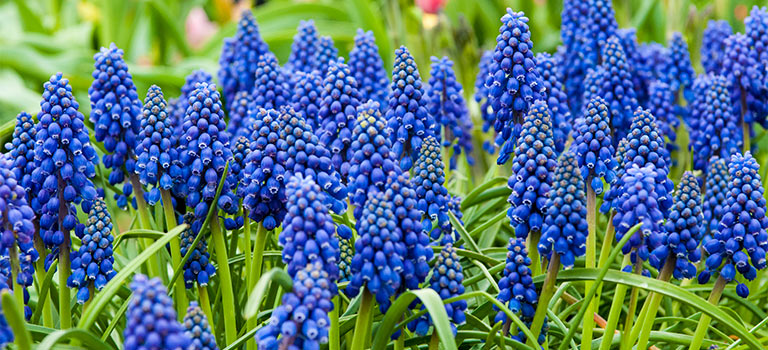Planting and Caring for Muscari
They’re colourful, carefree, vigorous and pleasantly scented. They have a well-deserved reputation as a reliable perennial and excellent naturalizer. They attract bees, but foraging deer and ravenous rodents tend to leave them alone, as do most insect pests.
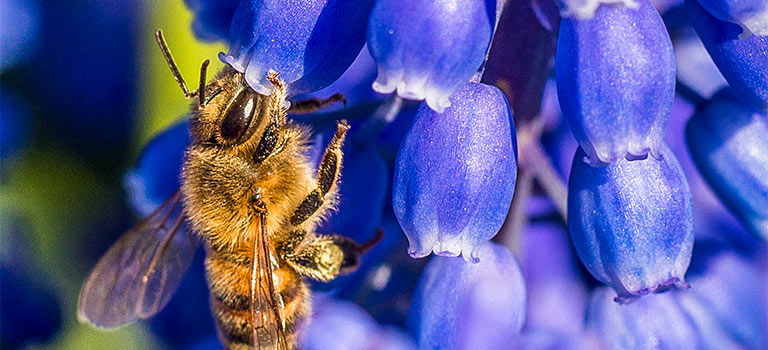
Little wonder, then, as to why gardeners and landscapers turn so often to muscari, and why our partners at iBulb decided to name it the 2019 Bulb of the Year.
Though commonly called grape hyacinths because of their resemblance to those flowers, the two are not directly related. Both used to belong to the Liliaceae family, but muscari is now considered to be in the Asparagaceae family.
Grape hyacinths are hardy in zones 3–9, which is most of the continental United States. They typically flower during mid to late spring. Because they are perennials that spread easily, they tend to return each year and in greater numbers.
Varieties of these charming workhorses bloom in shades of blue, violet, pink, yellow or white, plus bicolour combinations of those appealing hues. Their colours complement almost any other neighboring plant, so they are often grown for that purpose.
Grape hyacinths are native to southeastern Europe and southwestern Asia, and have been in cultivation since the 16th century. Some other facts:
- They are used in dried floral arrangements and as fresh-cut flowers.
- Some species are used in herbal medicine for their diuretic and stimulant properties.
- They are toxic to small children and pets.
Muscari are among the first bulb flowers to bloom during spring. The plants emerge from the ground early in the season to produce floppy, grasslike, green leaves before bearing blooms. After flowering, the foliage dies back in early summer but then starts growing again in mid fall. It continues through the winter, if the weather is mild.
A bulb produces one to three flowering stalks, each capped by a cluster of 20 to 40, tiny, tightly packed florets shaped like upside-down grapes and attached to the stalks by dozens of short stems. They release a mildly sweet fragrance reminiscent of grape juice.
The nodding florets open sequentially, beginning at the bottom and continuing to the top, with the lowest florets waning as the top ones are opening. When pollinated flowers wane, they are supplanted by seed pods. The plants readily naturalize, reproducing by division and self-seeding, and can even sometimes become invasive.
The jewel-like appearance of the clusters, called inflorescences, and the diminutive size of the plants—varieties reach only about 6–8″ tall—make them perfect for growing at the front of a spring bed or border, along a walkway, throughout a rock garden or woodland garden, or in a patio container.
Many people use the plants to brighten the shaded ground beneath deciduous trees or shrubs, or to underplant daffodils. Because bees are so fond of muscari, growing the plants near your fruit trees will increase the likelihood of their pollination.
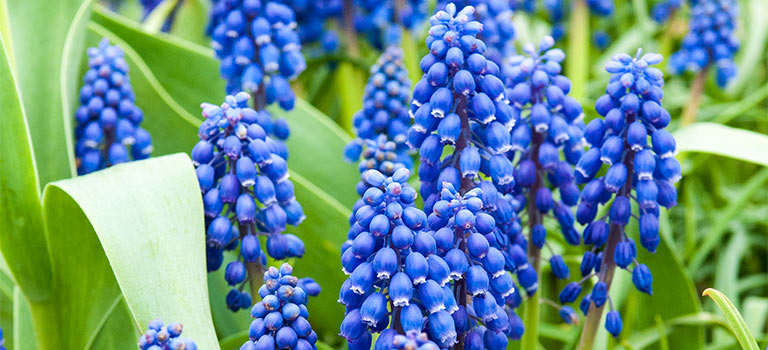
It can be fun to experiment with grape hyacinths. Try mixing muscari varieties or combining them with other bulbs, such as tulips or crocus. Their colours complement almost any other plant in the garden.
For a spectacular floral display that maximizes their impact on the landscape, plant grape hyacinth bulbs en masse in long, broad swaths. Such plantings can be used to link two gardens or to simply beautify an area.
When muscari are planted together in large numbers, their blooms take on a remarkable shimmering-water effect. Keukenhof, one of the world’s largest flower gardens, has a spectacular grape hyacinth planting known as “the blue river” that winds throughout the giant Dutch park. That planting consists of Muscari armeniacum, the most popular and widely cultivated variety. Also known as Armenian grape hyacinth, it features dark blue florets with white fringes.
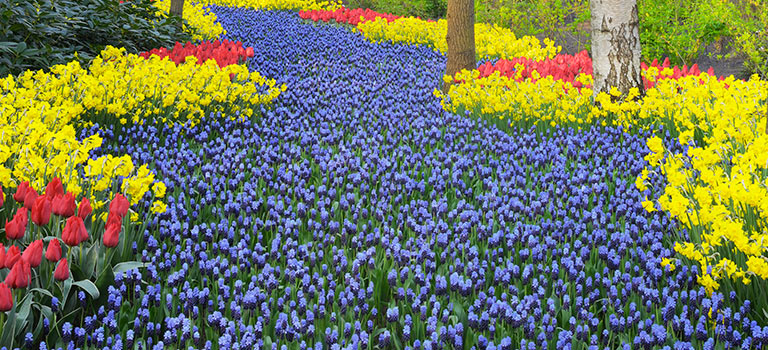
Although they require little attention in order to grow, spread and return each year, you’ll get the best results from your grape hyacinths by properly planting and caring for them. This will help you to enjoy these undemanding plants for many years.
Planting Outdoors
Like most spring-flowering bulbs, fall is the prime time for planting muscari. Do it a few weeks before your first expected frost. If planted early enough, they might produce foliage before freezing weather starts. This is their natural habit, so don’t worry if you see foliage emerge in the fall.
Leave the bulbs undisturbed from year to year. They will multiply freely without your help. The plants grow best in areas that receive full sun to partial shade. Avoid locations that are too dark because blooms won’t be as attractive or plentiful, and plants won’t multiply and spread as well.
Exercise caution when choosing a planting site—grape hyacinths spread very quickly and can become an invasive nuisance. You should plant them where you don’t mind them spreading freely.
When planting in gardens, a permeable, loose, humus-rich soil with a neutral pH level is ideal, but most soil types are suitable for muscari. Good-quality potting soil works best when planting in containers.
If pools of water remain on your desired planting site about five hours after a hard rain, it’s best that you look for another spot. While grape hyacinths aren’t fussy when it comes to soil type, they will rot in soggy soil or standing water.
If no other location is available or practical, at least amend the soil to improve its drainage. Try adding 2–3 inches of peat moss, compost or dried manure. Any one of them will do the job and are widely available.
After your order arrives, it’s important to open your bulbs and allow them to get some air. Store them in a cool, dry place with low humidity, such as an unheated garage or basement. A refrigerator is fine, but not if it’s also storing fresh fruit. Ethylene gas released by ripening fruit and trapped in the refrigerator will interfere with flower development. Never store flower bulbs in a freezer.
Healthy and viable muscari bulbs should be firm to the touch. Don’t worry about any marks, dimples or exterior discolouration they may have as a result of harvesting. The unattractiveness of the bulbs is irrelevant to the gorgeousness of the flowers they will produce.
Dig holes that allow your bulbs to be planted 3–4″ deep. Space them at least 2″ apart but make it 6″ apart if you are planning to allow them to natrualize. Be sure the pointed end of each bulb is facing up before covering it with soil.
Water the ground well to allow the soil to settle around the bulbs. If you’d like to add mulch, wait until after the first frost before covering the soil, and use no more than 2″ of mulch. Applying it sooner could slow the escape of heat from the ground, and the bulbs perform best when kept cool in the soil over the winter.
Grape hyacinths begin flowering in April or May. It will not harm your plants to cut their blooming flowers for use in bouquets or vases. After the blooming period, which lasts three or four weeks, they produce round, green seed pods, which can remain on the plants until well into summer.
Muscari easily multiply without seeds, so it’s best to snap off the spent flower clusters to halt the formation of the pods. This lets plants direct their energy towards next year’s blooms. They will still be able to naturalize with self-seeding because the bulb “mothers” create and nourish attached “baby bulbs” called offsets that sprout their own flowering stalks. The new bulbs eventually do the same, and so on.
In June, muscari begins a period of summer dormancy. The foliage starts dying and turning yellow, and if the sight of it offends your sensibilities, you can trim it off without jeopardizing the plants. In late August, it produces new, green leaves that must be left in place to provide sustenance to the plants over winter. The new leaves will collect sunlight and create food through photosynthesis, This foliage will remain evergreen until after next spring’s blooming period.
After several seasons of the plants regenerating and multiplying, you might find signs of overcrowding that limits their flower power. No worries. Just dig up some of the extra bulbs and replant them elsewhere in the garden. Be sure to carefully transplant them to reduce the likelihood of damage.
Forcing and Container Growing
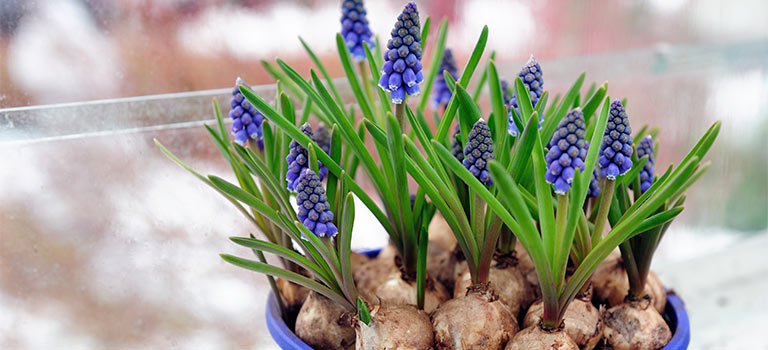
Grape hyacinths can also be forced indoors in containers over the winter, but keep in mind that, like most other spring-flowering bulbs, once muscari bulbs have been forced, they will no longer bloom when planted outdoors and should be discarded.
Before potting the bulbs, place them in a box and chill them in your refrigerator at a temperature of around 40°F, starting in mid-October. Meanwhile, fill your pots they will grow in with good-quality, commercially available potting soil. Make sure the pots have enough drainage holes to allow the soil to drain well, otherwise you’ll risk the bulbs becoming waterlogged and ruined.
After four weeks, quickly pot the cool bulbs, returning them to the refrigerator before they start warming up. Chill the pots for another four weeks at the same temperature, and regularly give them moderate amounts of water. The production of excess foliage should be reduced by following this two-step process because it allows plants to direct more of their energy to the flower clusters.
Remove the pots from the fridge and place them where desired in your home. Give them about an inch of water each week. The grape hyacinths will bloom in 2–6 weeks.
Shop All Grape Hyacinths/Muscari

